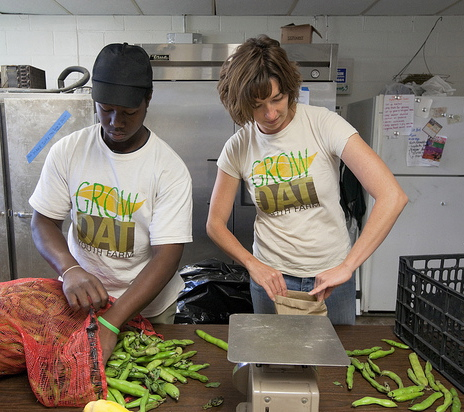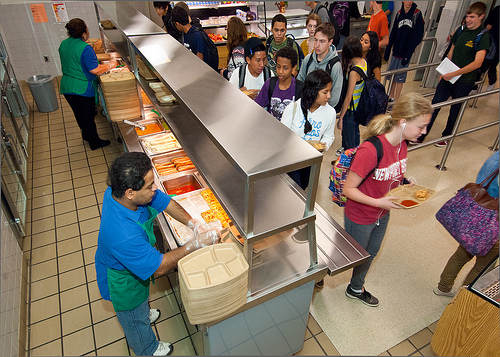 Photo: USDA I want to draw attention to an eye-opening investigative report on school lunch that has gotten a bit lost in the holiday shuffle. In a collaboration between The New York Times and the Investigative Fund, reporter Lucy Komisar delved into the billion-dollar business of the national school lunch program and found some unsettling news.
Photo: USDA I want to draw attention to an eye-opening investigative report on school lunch that has gotten a bit lost in the holiday shuffle. In a collaboration between The New York Times and the Investigative Fund, reporter Lucy Komisar delved into the billion-dollar business of the national school lunch program and found some unsettling news.
Komisar looked at two less-examined aspects of the school lunch program. The first is the practice of taking up to $1 billion of “surplus” fruits, vegetables, and meats that the USDA supplies to the program and, rather than cooking them into healthy meals, turning them into high-fat processed foods. The second is the surprisingly inefficient economics of outsourcing cafeteria services to private companies like Sodexo or Aramark.
As for the first practice, about $1 billion of surplus foods like apples, potatoes, and chicken are transferred from the USDA to schools for free every year. Only most schools don’t prepare the foods in their own kitchens — they pay processing companies, as Komisar says, “to turn these healthy ingredients into fried chicken nuggets, fruit pastries, pizza, and the like.”
And, of course, french fries.
Schools across the country have shut down their own kitchens in favor of facilities that can reheat and serve these processed foods. The logic was supposed to be irresistible — it combined the efficiencies of centralized food production with the simplicity of easily trained workers.
However, as Komisar observes, turning chicken into chicken nuggets isn’t all that cheap:
The Michigan Department of Education, for example, gets free raw chicken worth $11.40 a case and sends it for processing into nuggets at $33.45 a case. The schools in San Bernardino, Calif., spend $14.75 to make French fries out of $5.95 worth of potatoes.
… Roland Zullo, a researcher at the University of Michigan, found in 2008 that Michigan schools that hired private food-service management firms spent less on labor and food but more on fees and supplies, yielding “no substantive economic savings.”
Komisar also quotes another study by the Robert Wood Johnson Foundation which determined that this practice transformed perfectly good ingredients into foods that “have about the same nutritional value as junk foods.”
As one principal Komisar spoke to put it, in the wake of her district switching to management company Sodexo, “the savings were paltry … You pay a little less and your kids get strawberry milk, frozen French fries, and artificial shortening.” Every day.
But what really gets me about all of this isn’t just the fact that we’re willingly shelling out serious money to turn healthy ingredients into junk, but that we’re also taking good jobs out of communities that need them:
School kitchen workers are generally unionized, with benefits; they are also typically local residents who have children in public schools and care about their well-being. Laid-off school workers become an economic drain instead of a positive force. And the rebate deals with national food manufacturers cut out local farmers and small producers like bakers, who could offer fresh, healthy food and help the local economy.
Talk about a double whammy. And this being corporate America, there’s a healthy dose of corruption to go along with it. Last year, private cafeteria companies were caught paying illegal rebates to food processors — rebates that weren’t passed on to the school districts. As then-New York Attorney General Andrew Cuomo stated in a comment on a $20 million fine paid by Sodexo in New York for the practice, “This company cut sweetheart deals with suppliers and then denied taxpayer-supported schools the benefits.”
Shockingly, Komisar has discovered that these illegal rebates have crept back in the form of “prompt payment discounts” — a form of kickback that is, under USDA rules, legal.
Is it any wonder that Congress has fought the USDA’s attempt to reform school lunch in the form of the much-mocked and maligned Defense of Pizza and Potato Acts? It would be funny if not for the fact that so much money is riding on these ridiculous laws.
This battle by corporations and Congress to keep our schoolkids eating junk food comes even as the scientific evidence piles up that school is the best place to battle obesity — both through increased exercise and healthier food. In fact, this study out of Australia, published in Cochrane Library, indicates that school-based programs that try to increase activity levels among kids aged 6-12 may actually reduce obesity — which is impressive since research suggests that exercise-based interventions are not particularly effective in other age groups. And the study goes on to observe that the U.S. lags behind most other countries in adoption of such school-based interventions. Apparently, we do crony capitalism really well, and that’s about it.
There are some amazing school lunch reforms going on, thanks to movers and shakers like Ann Cooper and organizations like Food Corps. But Komisar’s article reminds us that when billions of dollars are sloshing around the system, even the best reforms can seem like small potatoes.
Related Series




